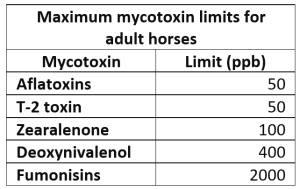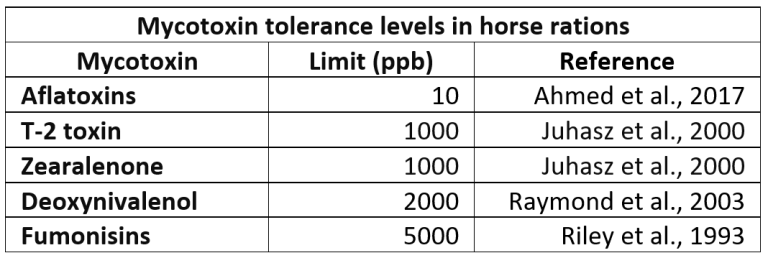Ensuring the safety of raw materials and food has become a significant challenge for animal production over the past decades. Today, the livestock industry faces various factors that threaten animal health and, consequently, human health. One of the most persistent problems is mycotoxin contamination, which affects both production systems and livestock management (Jedziniak et al., 2019). Mycotoxin contamination, secondary metabolites produced by fungi that can be found in animal feed, is a globally widespread concerning. Its origin is directly related to the raw materials used in animal nutrition, environmental conditions, and the handling processes of the feed itself.
In the case of horses, their diet is specifically based on pasture, hay, and cereals in a nutritional concentrate. These can be naturally contaminated by mycotoxins produced by fungi, which develop before, during, or after harvest, including during storage. In this context, contamination of horse feed by mycotoxins represents a significant challenge associated with major health and performance problems in the equine industry.
Despite the lack of information and studies on the effects of mycotoxins in horses, it has been described that the main type of mycotoxins affecting these animals are fumonisins, especially fumonisin B1 (FB1) and fumonisin B2 (FB2). These mycotoxins have been strongly linked to outbreaks in this species. However, equine mycotoxicosis has also been observed from contamination by aflatoxins, deoxynivalenol, T-2 toxin, ochratoxin A, zearalenone, and ergot alkaloids. On the other hand, it is worth noting that, compared to other monogastric animals, horses are considered less sensitive to aflatoxin contamination (Mobashar, 2022).
Maximum mycotoxin limits in horses
According to equine nutritionist Dr. Kyle Newman from Venture Laboratories in the United States, maximum concentrations of mycotoxins have been established for adult horses (Table 1). However, it is important to consider various factors that are excluded from these limits, such as breeding or young horses, or scenarios involving co-contamination, where synergistic effects between different mycotoxins may occur. According to a review by Dr. Mobashar based on various studies, tolerance levels for different mycotoxins in horse rations have also been determined (Table 2) (Mobashar, 2022).

Table 1. Maximum mycotoxin limits for adult horses according to Dr. Kyle Newman.

Table 2. Mycotoxin tolerance levels in horse rations (Mobashar, 2022).
Effects of mycotoxins in horses
Aflatoxins
Aflatoxins, mycotoxins produced by fungi of the Aspergillus genus, are widely known for their carcinogenic effects. These toxins are associated with negative impacts on equine health, as most horse forages contain corn, oats, and other cereals, which are highly susceptible to aflatoxin contamination.
Equine aflatoxicosis is mainly linked to aflatoxin B1 (AFB1), which has been associated with nonspecific clinical signs such as coughing, loss of appetite, depression, fever, tremors, and ataxia; as well as liver lesions like centrilobular necrosis, cholestasis, and bile duct proliferation. These liver issues are monitored through changes in plasma levels of transaminases (AST, ALT) and alkaline phosphatase (ALP) (Caloni et al., 2011).
In ponies, microscopic liver lesions induced by AFB1 have also been observed, such as centrilobular fatty change, hepatic cell necrosis, and periportal fibrosis. These lesions were accompanied by elevated transaminase levels, total plasma bilirubin, and alterations in the icteric index. General symptoms like depression, anorexia, and weakness were also reported.
Some studies have indicated that AFB1 may induce a heightened immune response by increasing leukocyte counts, especially neutrophils (Braga et al., 2020). Additionally, this mycotoxin is known to affect olfactory and respiratory tissues in horses through inhalation, potentially inducing Chronic Obstructive Pulmonary Disease (COPD), a condition characteristic of the species (Larsson et al., 2003).
Fumonisins
Fumonisins are mycotoxins produced by Fusarium species. Horses are particularly susceptible to concentrations of FB1 ranging from 0.02 to 0.12 µg/g. This mycotoxin has been linked to Equine Leukoencephalomalacia (ELEM), a neurological disorder characterized by clinical signs such as sweating, difficulty swallowing, muscle weakness, incoordination, ataxia, hypermetria, circling, head pressing, tonic-clonic seizures, paresis, hyperexcitability or depression, blindness, dilated pupils, and loss of pupillary light reflex (Bertero et al., 2018).
Associated with this syndrome, FB1 intoxication has been shown to induce cardiovascular dysfunction by decreasing cardiac output, producing negative chronotropic and inotropic effects, and reducing arterial pulse pressure. It is believed that FB1 disrupts sphingolipid metabolism, critical for cell membrane structure, potentially affecting calcium channels. Other hypotheses suggest that these alterations may contribute to the development of ELEM, damaging cerebral vessels and reducing heart activity (Bertero et al., 2018; Van der Westhuizen et al., 2001).
Trichothecenes
Both deoxynivalenol (DON) and T-2 toxin belong to the trichothecene group. DON has commonly been associated with feed refusal in horses, as it causes metabolic disruptions leading to appetite loss (Trenholm et al., 1994). Studies in horses fed contaminated forages recorded a decrease in feed intake accompanied by increased AST levels, indicating liver damage (Raymond et al., 2003a).
Moreover, DON has also been linked to respiratory issues in horses due to its damaging effects on the integrity and morphology of the respiratory epithelium (Cleemput et al., 2019). However, horses appear to tolerate this mycotoxin better than other monogastric species (Schulz et al., 2015). DON exposure has also been associated with colic development and elevated AST, ALT, and ALP levels (Dänicke et al., 2021).
T-2 toxin, on the other hand, is considered less common but more toxic than DON, although it is less studied. In mares, T-2 toxin can cause oral lesions, but no intestinal damage or effects on ovarian activity have been observed, as seen in other species (Juhasz et al., 1997).
Ochratoxin A
Ochratoxin A is a potent nephrotoxic and teratogenic mycotoxin. Ochratoxins are mainly produced in starchy cereal grains such as corn and wheat due to their moisture content of 15.5–16%. It is known that ochratoxin A enters the circulatory system via the portal vein and lymphatic vessels, binding to plasma proteins, especially albumin. There is limited information about the absorption of this mycotoxin in horses, but existing literature suggests that, as in other monogastric animals, it is likely absorbed in the proximal part of the small intestine (Di Paolo et al., 1993). However, further studies are needed to determine its effects on equine health.
Zearalenone
Zearalenone, a secondary metabolite of Fusarium species, is an estrogenic mycotoxin that binds to estrogen receptors, causing hyperestrogenism. This syndrome is characterized by uterine enlargement, rectal and vaginal prolapse, and other reproductive effects. Specifically, a study in mares showed that administration of 1 ppm of this mycotoxin induced lesions on the skin around the mouth (Juhasz et al., 2001).
In commercial horse farms, mycotoxicosis symptoms were observed at a feed dose of 2.7 ppm, with strong estrogenic effects after 30 days of feeding (Gimeno et al., 1983). Conversely, horses are considered less sensitive to this mycotoxin than other species due to their production of a less active metabolite, ß-zearalenol, instead of α-zearalenol (Vance et al., 2019).
In vitro studies have shown cellular alterations in granulosa cells isolated from equine ovaries caused by zearalenone. Moreover, both α- zearalenol and ß- zearalenol have been associated with changes in the chromatin structure of equine sperm cells (Minervini et al., 2010). These findings suggest that zearalenone acts as a reproductive disruptor in horses.
Conclusions
Mycotoxins in horse feed can cause liver damage, neurological disorders, feed refusal, and reproductive issues, among others. Although horses are generally less sensitive to these toxins than other species, they still represent a significant risk to equine health and performance, being linked to severe conditions such as Equine Leukoencephalomalacia.


